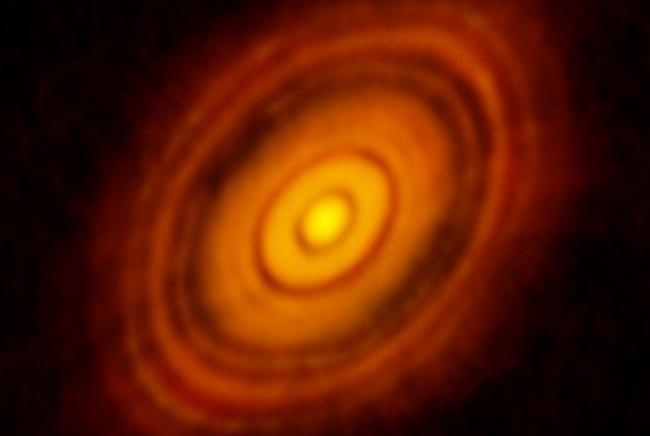Disks
Our Work
Center for Astrophysics | Harvard & Smithsonian scientists study the various types of astronomical disks in many ways, including:
-
Mapping material in the innermost part of an accretion disk around a black hole using the Event Horizon Telescope (EHT), a powerful multi-observatory array spanning the globe from Hawaii to the South Pole. This map revealed details of the disk and of the supermassive black hole it surrounds, providing the first image of a black hole.
CfA Plays Central Role In Capturing Landmark Black Hole Image -
Using telescopes designed to observe light in the millimeter and submillimeter range, to understand the chemistry of disks surrounding protostars. Observatories such as the Atacama Large Millimeter/submillimeter Array (ALMA) and the Submillimeter Array (SMA) are particularly well-suited to find chemicals that are potential precursors for life.
Complex Organic Molecules Discovered in Infant Star System -
Looking for signs of newborn planets in protoplanetary disks. The position and size of these new worlds within their disks tell us something about how planets form, and whether they move from their initial positions. This has implications for our own Solar System, which is a product of a long history we can’t observe directly.
Disk Gaps Don't Always Signal Planets -
Using NASA’s Chandra X-ray Observatory and other telescopes to study accretion disks around white dwarfs, neutron stars, and stellar-mass black holes. That includes the study of millisecond pulsars: neutron stars that accrete matter from a companion and rotate hundreds of times each second. The disks in these systems are the key to understanding how these objects spin so fast.
Millisecond Pulsars -
Studying accretion disks around supermassive black holes at the centers of galaxies, which can be some of the brightest objects in the universe. The Chandra X-ray Observatory is particularly good at mapping the details of how black holes eat and scatter chemicals across their host galaxies.
Supermassive Black Hole Spins Super-Fast
From Disks to Planets
The force of gravity tends to make things into spheres, which is why planets and stars are round. However, spinning flattens objects out: gas clouds, stars in spiral galaxies, and other systems form disks under rapid rotation.
Stars form out of clouds of gas, which slowly collapse under the force of gravity. The atoms and molecules in the gas impart a small amount of rotation as they fall toward the protostar. That rotation gives the star its spin and creates a rotating platter of gas and dust called a protoplanetary disk. The composition of that disk, including how much mass it has, determines how many planets and what kind are formed.
We are still puzzling out exactly how planets form from these beginnings, since the other known planetary systems don’t resemble our Solar System. Astronomers study disks to understand how they turn into planets, and how those newborn planets move around in the infant system. They also want to know how the various atoms and molecules distribute themselves within the disk, to understand where important chemicals like water and organic molecules end up. That has implications for life, both in the Solar System and elsewhere.

The young star HL Tau is surrounded by a protoplanetary disk, as seen in this image from ALMA. The rings and gaps in the disk mark the likely presence of newborn planets as they gather up dust and gas.
Accretion Disks
Compact objects have far more intense gravity than stars. These objects are white dwarfs, neutron stars, or stellar-mass black holes — those formed from the deaths of massive stars. When these are in binary systems with ordinary stars, the gravitational tidal force from the compact object can pull the star out of shape to the point where gas flows from the star to its companion. This matter forms an accretion disk, which is much hotter and spins faster than a protoplanetary disk.
As with protoplanetary disks, astronomers study accretion disks to understand the physical processes that make them. Accretion is the precursor to powerful cosmic phenomena like type Ia supernovas, when white dwarfs attract enough mass that they explode. Neutron stars and black holes in binary systems with ordinary stars can be very bright X-ray sources, as the gas they strip from their companion heats up to incandescent temperatures.
Accretion disks around supermassive black holes are made from gas pulled in by the black hole. These are the fuel for active galactic nuclei, including the quasars visible from billions of light-years away. Understanding accretion disks is essential for knowing how supermassive black holes feed and scatter atoms around the galaxy.
- Planetary Systems
- Stellar Astronomy
- The Milky Way Galaxy
- Theoretical Astrophysics
- Computational Astrophysics
- The Energetic Universe
Related News
It's a Planet: New Evidence of Baby Planet in the Making
Case Solved: Missing Carbon Monoxide was Hiding in the Ice
CfA Scientists Awarded Prestigious NASA Hubble Fellowships
Exoplanets in Debris Disks
Planets Form in Organic Soups with Different Ingredients
The Dust and Gas in Protoplanetary Disks
Planetary Remnants around White Dwarf Stars
Spotted: An Exoplanet with the Potential to Form Moons
Harvard Radcliffe Institute Honors Astrophysics Senior with Highest Distinction
Three Incoming Postdoctoral Researchers Awarded NASA Hubble Fellowships
Projects
AstroAI
From Molecular Cores to Planet Forming Disks (c2d)
Telescopes and Instruments
Chandra
Visit the Chandra Website
Event Horizon Telescope (EHT)
Visit the EHT Website
SOFIA (Stratospheric Observatory for Infrared Astronomy)
Visit the SOFIA Website
The Submillimeter Array - Maunakea, HI
Visit the Submillimeter Array Website